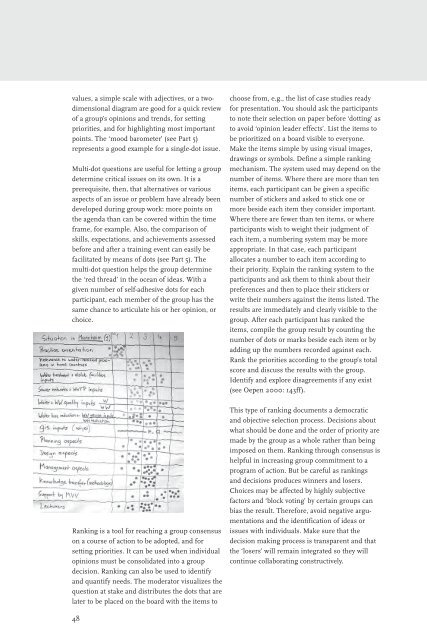MOVE - Moderation and Visualization for Group ... - INSPIRATION
MOVE - Moderation and Visualization for Group ... - INSPIRATION
MOVE - Moderation and Visualization for Group ... - INSPIRATION
Create successful ePaper yourself
Turn your PDF publications into a flip-book with our unique Google optimized e-Paper software.
values, a simple scale with adjectives, or a twodimensional<br />
diagram are good <strong>for</strong> a quick review<br />
of a group’s opinions <strong>and</strong> trends, <strong>for</strong> setting<br />
priorities, <strong>and</strong> <strong>for</strong> highlighting most important<br />
points. The ‘mood barometer’ (see Part 5)<br />
represents a good example <strong>for</strong> a single-dot issue.<br />
Multi-dot questions are useful <strong>for</strong> letting a group<br />
determine critical issues on its own. It is a<br />
prerequisite, then, that alternatives or various<br />
aspects of an issue or problem have already been<br />
developed during group work: more points on<br />
the agenda than can be covered within the time<br />
frame, <strong>for</strong> example. Also, the comparison of<br />
skills, expectations, <strong>and</strong> achievements assessed<br />
be<strong>for</strong>e <strong>and</strong> after a training event can easily be<br />
facilitated by means of dots (see Part 5). The<br />
multi-dot question helps the group determine<br />
the ‘red thread’ in the ocean of ideas. With a<br />
given number of self-adhesive dots <strong>for</strong> each<br />
participant, each member of the group has the<br />
same chance to articulate his or her opinion, or<br />
choice.<br />
Ranking is a tool <strong>for</strong> reaching a group consensus<br />
on a course of action to be adopted, <strong>and</strong> <strong>for</strong><br />
setting priorities. It can be used when individual<br />
opinions must be consolidated into a group<br />
decision. Ranking can also be used to identify<br />
<strong>and</strong> quantify needs. The moderator visualizes the<br />
question at stake <strong>and</strong> distributes the dots that are<br />
later to be placed on the board with the items to<br />
48<br />
choose from, e.g., the list of case studies ready<br />
<strong>for</strong> presentation. You should ask the participants<br />
to note their selection on paper be<strong>for</strong>e ‘dotting’ as<br />
to avoid ‘opinion leader effects’. List the items to<br />
be prioritized on a board visible to everyone.<br />
Make the items simple by using visual images,<br />
drawings or symbols. Define a simple ranking<br />
mechanism. The system used may depend on the<br />
number of items. Where there are more than ten<br />
items, each participant can be given a specific<br />
number of stickers <strong>and</strong> asked to stick one or<br />
more beside each item they consider important.<br />
Where there are fewer than ten items, or where<br />
participants wish to weight their judgment of<br />
each item, a numbering system may be more<br />
appropriate. In that case, each participant<br />
allocates a number to each item according to<br />
their priority. Explain the ranking system to the<br />
participants <strong>and</strong> ask them to think about their<br />
preferences <strong>and</strong> then to place their stickers or<br />
write their numbers against the items listed. The<br />
results are immediately <strong>and</strong> clearly visible to the<br />
group. After each participant has ranked the<br />
items, compile the group result by counting the<br />
number of dots or marks beside each item or by<br />
adding up the numbers recorded against each.<br />
Rank the priorities according to the group’s total<br />
score <strong>and</strong> discuss the results with the group.<br />
Identify <strong>and</strong> explore disagreements if any exist<br />
(see Oepen 2000: 143ff).<br />
This type of ranking documents a democratic<br />
<strong>and</strong> objective selection process. Decisions about<br />
what should be done <strong>and</strong> the order of priority are<br />
made by the group as a whole rather than being<br />
imposed on them. Ranking through consensus is<br />
helpful in increasing group commitment to a<br />
program of action. But be careful as rankings<br />
<strong>and</strong> decisions produces winners <strong>and</strong> losers.<br />
Choices may be affected by highly subjective<br />
factors <strong>and</strong> ‘block voting’ by certain groups can<br />
bias the result. There<strong>for</strong>e, avoid negative argumentations<br />
<strong>and</strong> the identification of ideas or<br />
issues with individuals. Make sure that the<br />
decision making process is transparent <strong>and</strong> that<br />
the ‘losers’ will remain integrated so they will<br />
continue collaborating constructively.
















